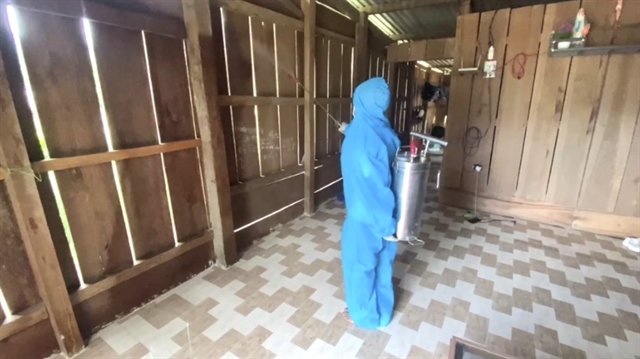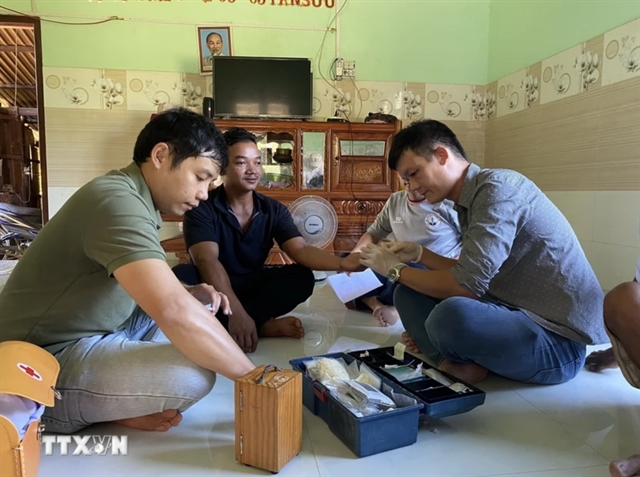 Society
Society

 |
| Spraying mosquito repellent in a house of Khánh Vĩnh District of Khánh Hòa Province. — Photo baokhanhhoa.vn |
KHÁNH HÒA — Khánh Hòa Province recorded 123 cases of malaria in the first five months of this year, the provincial health district reported.
In Khánh Vĩnh district alone, there have been 114 cases of malaria recorded, with dozens of severe cases, of which nearly 80 per cent of the cases are male and around 25 per cent are children aged between five and fifteen years old.
According to epidemiologists, this is the highest number of cases to date in the province in this period. Therefore, it is crucial to implement and synchronise multiple decisive measures to prevent and control malaria in the area.
The Khánh Hòa Centre for Disease Control (CDC) reported that the number of malaria patients in the province gradually decreased from 2018 to 2022.
2018, the entire province recorded 125 cases, which fell to 12 cases by 2022.
However, from 2023, the number of cases increased significantly to 209, including one fatality of a Vietnamese overseas citizen due to malaria.
In July last year, malaria cases surged to a rate of 50 cases per month, then gradually decreased, with 22 cases per month recorded by the end of the year.
Most of these cases were among individuals who ventured into forests and slept in fields in the mountainous district of Khánh Vĩnh.
This year, despite the vigorous implementation of malaria prevention and control measures, the number of cases has risen sharply in the province, even though it is not currently the usual peak malarial season.
Huỳnh Hồng Quang, deputy director of the Malaria-Parasitology-Insects Institute, said that an abnormal increase in malaria cases in Khánh Hoà Province since the beginning of the year, is deviating from the usual seasonal pattern.
Quang said that if the locality does not take decisive measures during the peak periods of the epidemic, from now until the end of August and from November to February 2025, the risk of a surge in malaria cases will increase significantly.
In Khánh Vĩnh District, 12 out of 14 communes and townships have malaria cases. Particularly in Khánh Phú and Khánh Đông communes, nearly 100 per cent of the detected cases are attributed to the P. falciparum strain of malaria parasites. In contrast, cases in Khánh Thượng Commune are linked to the P. Malariae strain of malaria parasites.
During the first few months of the year, Khánh Vĩnh District recorded 114 cases, including dozens of severe malaria cases. Males accounted for nearly 80 per cent of the cases and around 25 per cent were children aged between five and fifteen years old. Most of the cases are those who sleep in makeshift shelters in the wilderness, ten of the cases are forest rangers.
 |
| Health workers provide a malaria test at home in Khánh Hòa Province. — VNA/VNS Photo |
A survey conducted by the Malaria-Parasitology-Insects Institute in 30 households in forested areas in Khánh Vĩnh District showed that most people do not use mosquito nets while sleeping, creating favourable conditions for mosquitoes to transmit the disease.
In addition, many individuals in the community still carry malaria parasites without exhibiting any symptoms, potentially becoming a source of infection when bitten by mosquitoes.
According to Tôn Thất Toàn, deputy director of the provincial CDC, aside from Khánh Vĩnh District, the situation regarding the other nine malaria cases in the province has been effectively controlled, with no new sources of transmission identified.
The Health Centre of Khánh Vĩnh District has imposed measures to prevent and control malaria in the district, but some significant challenges persist. The pathogen still exists in the forest areas and with the livelihoods of many of the local residents linked to work there, it is difficult to cut off the source of transmission.
The district has conducted various forms of communication including radio broadcasts and has sent out medics to offer tests and treatments.
However, the community remains negligent in malaria prevention and control, especially in participating in testing and reporting to local healthcare authorities after returning from the forest. This hinders early detection, treatment, and prevention of malaria from spreading into the community. — VNS




